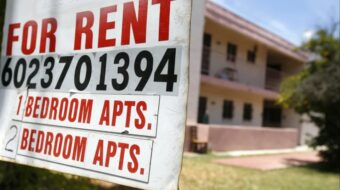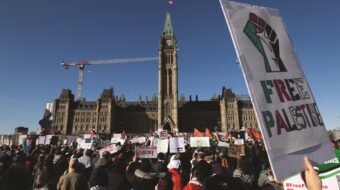VANCOUVER – While the U.S. is still suffering from the sub prime debacle, Canada’s housing market is an island of tranquility. House prices continue to rise, people are buying houses and apartments and paying their mortgages. The banks are on a solid footing, making profits and not facing bankruptcy or asking for bailouts.
According to the federal government, the media, business economists and the real estate industry, the Canadian real estate market is balanced and healthy because of the bank’s prudent lending practices and government regulation. Unlike the U.S., the government never allowed sub primes loans and therefore no housing bubble emerged. The health of Canadian financial institutions has been praised abroad.
However, critics are beginning to question this rosy picture of the Canadian housing market. They point out that if you scratch below the surface, the Canadian housing market shares many eerie similarities with the US market before the sub-prime housing bubble began to deflate in 2006. House and apartment prices have gone up more than 100 percent since 2000 and are at least double the price compared to the U.S. market. In the U.S., the average house costs $173,000 while in Canada it is $348,178. In Vancouver, where the housing bubble is the most extreme, the average single family home costs $900,000 Cdn. Buying a house or apartment has become unaffordable for most Canadian working people.
According to Garth Turner, a former Conservative Party Cabinet Minister and Member of Parliament, the Conservative government of Stephen Harper has deliberately created a housing bubble through low interest rates and down payments and long amortization periods that is beginning to deflate. The Canadian government, through the Bank of Canada, has kept interest rates low at emergency levels. By 2009 they were lowered to less than 1 percent. Today it sits at 1 percent. The vast majority of mortgage holders in Canada have 5 year fixed mortgages at 3.5 percent interest. In the past, home loans were in the 8 percent range.
The Canadian government requires that buyers only pay 5 percent down payments although this rule is not enforced. However, for buyers who do not have 5 percent, the 6 major banks offer no down payment mortgages or cash back mortgages where they loan the buyer the 5 percent down payment, offering 100 percent financing. The banks also give mortgages to the self-employed and new immigrants without verifying income.
In the past, Canadian banks required down payments of 25 percent, but this amount was gradually lowered. The Conservative government “embraced the sub-prime culture as nobody has done before”, writes Turner on his Greater Fool Website. After 1999, it lowered down payments from 10 percent to 5 percent. From 2006 to 2008, Parliament even passed legislation allowing 0 percent down payments and 40-year amortization periods.
Until last year the government allowed the Banks to offer 35-year mortgages to buyers, and before that 40 years. To cool the housing market, the federal Conservative government last year lowered mortgages to 30-year repayment periods. Now there is speculation that Finance Minister Jim Flaherty will kill the 30-year mortgage and reduce it to 25 years.
Turner contends that 5 percent or no down payments, low interest rates and long repayment periods have expanded the number of buyers who have bid up housing prices to unsustainable levels and pushed ownership levels to 70percent of the population. Meanwhile, for most Canadian working people, wages have stagnated or failed to keep up with inflation. Unemployment (including involuntary part timers and discouraged workers) is around 10.6 percent, some 2 million workers, and economic growth is beginning to stall.
Many Canadians have also used their homes as ATMs, taking out additional loans using their homes as collateral to finance private consumption. Lines of credit backed by homes made up 50percent of all consumer credit last year, largely to finance home renovation.
The federal government has insured all these low down or no down payment mortgages through the Canadian Mortgage and Housing Corporation (CHMC), a state housing agency whose 10 member Board of Governors is heavily represented by the Housing industry — 3 developers, 1 real estate broker and 1 partner in a plumbing, renovation company. The CHMC would be the Canadian equivalent of the US government backed Freddy Mac and Fanny Mae insurance holders. The banks therefore can lend money to house buyers with zero risk. By removing risk from lenders who do not have to worry about the credit worthiness of the borrower, the government has encouraged imprudent lending practices, according to Turner. The Harper government even increased the agency’s insurable loan limit to $600 billion in 2009, an amount larger than the national debt.
Like in the US, Canadian banks are bundling these risky mortgages into securities and selling them to unwary investors.
Turner argues that the 5percent down payments are Canada’s version of US sub prime loans. Many new buyers have bought expensive homes for 5 percent or less at low interest rates that will eventually reset to higher levels, at least double the current low interest rate today of 3.5 percent. The Bank of Canada has been warning over the last year that it will eventually raise interest rates and has been urging Canadians to pay down debt before rates go up. Recently, federal finance Minister Jim Flaherty told reporters that, “interest rates are going to go up. They have nowhere to go but up. So people must make sure that they can afford higher mortgage interest.”
“We’ve systematically lowered mortgage-lending standards, encouraged banks to take excessive risk, eliminated the need for money when buying real estate, and turned what used to be an accomplishment and a privilege into a right and an entitlement. Now that 70percent of us have swilled the kool – aid, pushing prices house prices and debt levels to historic highs, a melt in both sales and prices seems inevitable”, writes Turner.
Turner warns that when interest rates go up, mortgage payments will increase and housing prices decline. Many Canadians will face negative equity where they are left paying mortgages that exceed the value of their properties, as in the US, causing economic distress, hardship and a wave of foreclosures. Turner says this is beginning to happen in smaller towns and cities across Canada. A decline in housing prices will also hit the economy hard, as housing spending constitutes 20percent of the Canadian economy. For mortgage owners who cannot pay their mortgages that are insured by the CHMC, the Canadian taxpayer will be on hook to pay the banks, states Turner.
Lax lending practices and climbing house prices have increased household debt to their highest levels. Canadians now have higher per-capita debt levels than Americans and British. For every dollar of income, Canadians owe $151. Debt levels continue to increase each month, much of it mortgage debt, and show no sign of halting. Bank of Canada Governor Mark Carney calls these debt levels “the greatest risk to the domestic economy.”
Financial analyst Ben Radiboux shares many of Turner’s concerns about the Canadian housing bubble. “In real terms, prices have risen higher and for a longer length of time than at any point in time over the last 40 years [as far back as there is data on house prices]. Relative to underlying fundamentals, things have never looked so ugly”, writes Radiboux on his website Economic Analyst. “The balance of probabilities leans strongly towards a housing price correction.”
Radiboux argues that there are similarities between US sub prime lending before 2006 and Canadian lending practices today. US lenders gave mortgages at low fixed teaser interest rates for 2 years before resetting to a higher rate adjusted every 6 months for the rest of the mortgage. Canada’s fixed mortgages, carrying an average interest rate of 3.5percent, reset every 5 years, exposing borrowers to interest rate fluctuations. A Bank of Canada stress test last year showed that a 0.5percent increase in interest rates would put 1.1 million households ” under significant financial pressure.”
High loan-to-value mortgages were another feature of sub prime lending in the U.S. where debt is greater than 90percent of the value of the home itself. Yet, CMHC insures mortgages where loan to value is 95percent (5 percent down payment). In addition, Canada’s 6 large banks offer 100 percent financing for home purchases with no down payment mortgages and cash back mortgages where they lend the buyer the 5percent down payment.
Radiboux is critical of the CHMC for not being forthright in disclosing the makeup of their insured portfolio, exposing the Canadian taxpayer to great risk in the event of a housing crash.
Another factor that will help depress housing prices is demographics, claims Radiboux. Nine million baby boomers will be retiring in the next few years and many of them will be selling their houses to help finance retirement or simply to downsize into a smaller living space.
It is not just Turner and Radiboux who have been ringing the alarm bells about the Canadian housing bubble. The Bank of Canada said that Canadians are becoming increasingly vulnerable to a housing correction, exposing them to a perfect storm of high debt and falling assets. The International Monetary Fund has also warned that Canada could face a price correction if house prices and debt levels do not come under control.
Capital Economics, a British macro research consultancy that provides independent economic analysis to the global corporate and financial sector, is predicting that Canadian housing prices will crash by as much as 25 percent when the Canadian housing bubble falls.












Comments